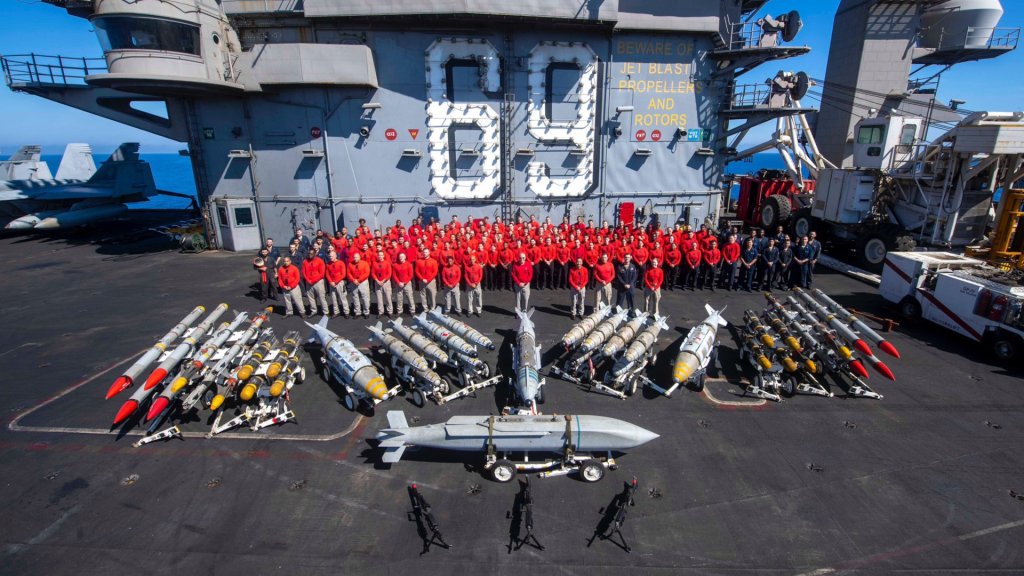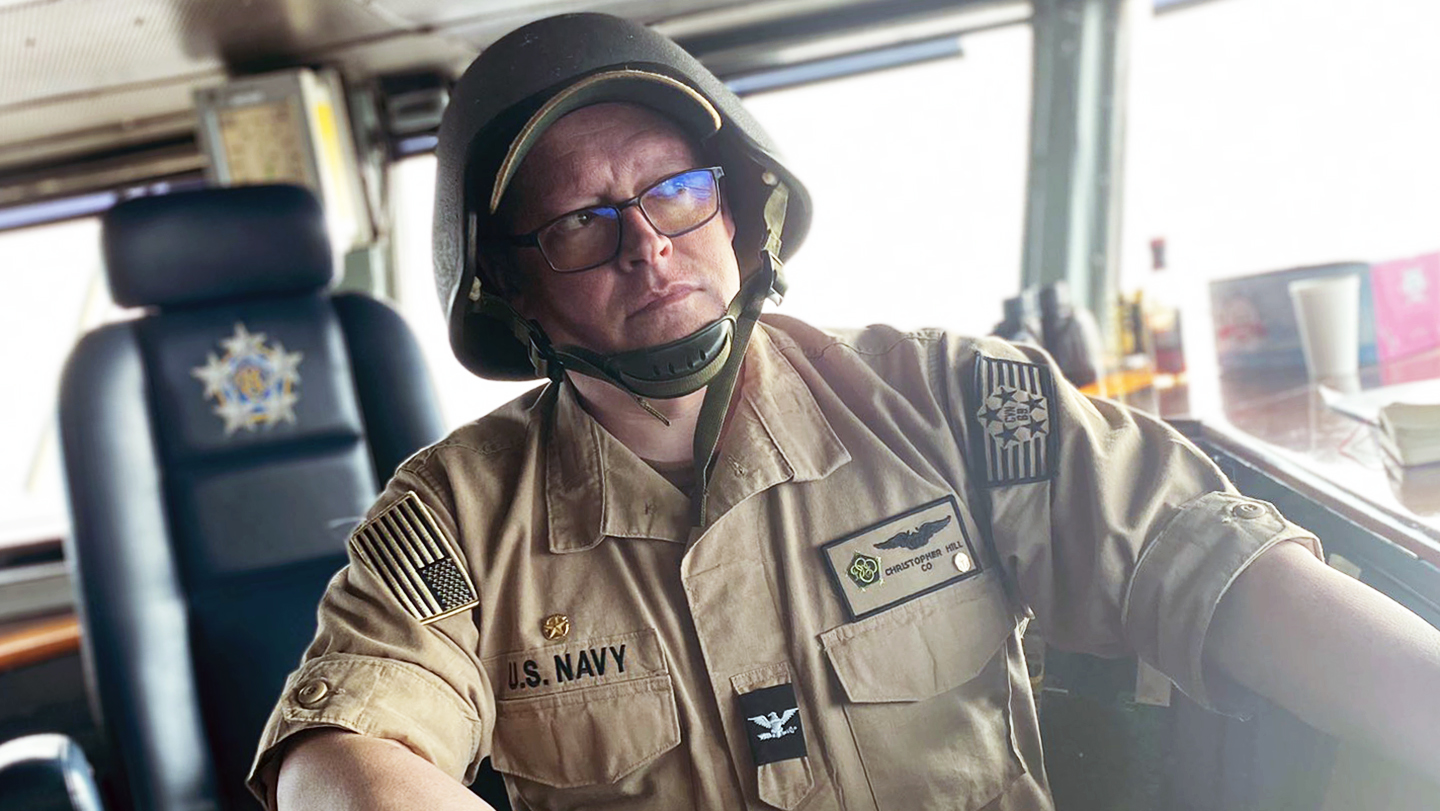When unfounded rumors began to circulate online earlier this year that the aircraft carrier USS Dwight D. Eisenhower was sunk by Houthis missiles, its captain, Chris “Chowdah” Hill, took to social media to let the world know the Ike was perfectly fine. Not with a direct denial, but with a tweet showing him eyeing pastries in the massive ship’s bake shop. But that didn’t mean that Hill didn’t worry about how his up-beat social media presence would have to abruptly change if the ship was indeed struck by the enemy.
A few days earlier, after similar rumors, Hill posted about Taco Tuesday. But unlike the latter tweet, he wasn’t delivering a message, he told Michael Villahermosa, an Army captain who hosts the It’s A Blast Podcast in his spare time.

“The first time was just an accident where the enemy claimed that they had sunk us,” he said. “…despite every attempt that they may have made, they did not. And so it just happened to fall on a Tuesday, and I love Taco Tuesday.”
He also retweeted a story about the Houthi disinformation campaign that he subtly helped to counter.
Perhaps the most known aircraft carrier skipper of his generation thanks to his popular @ChowdahHill Twitter/X account, the taco-loving Hill explained that his social media presence would have been significantly different had the Eisenhower really suffered damage.
“If the ship had been hit, then what would the tenor of my social media have become at that point?” he asked Villahermosa rhetorically. “Am I going to still talk about Taco Tuesday when there’s a gaping hole in the side of the ship?”
At the time, the rumors of the Ike being struck sparked wide concern, with reporters reaching out to sources to debunk or confirm the claims. It was the kind of news that could spread panic among the families of the 5,000 sailors on board. Given that, Hill’s Twitter account became the front lines of an information warfare battle waged by the Houthis to stir up fear over the deployment of combat assets to the region. It’s a unique but glaring example of the challenges and opportunities militaries face in an age of social media, where disinformation can spread like wildfire and tweeting from a deployed warship can present unique pitfalls and tactical benefits.
Hill said he had some trepidation after those tweets because he’d “received negative feedback” that his plethora of posts about daily life aboard ship “might have been revealing too much.” They included images of deployment patches, his morale-building invitations to sailors to have a cookie on the bridge, Captain Demo, Ike‘s roving therapy dog, and of course his beloved Red Sox.
“So I did worry about that a little bit,” he told Villahermosa, who stressed that the Army neither endorses nor sponsors his podcast. “I’m like, ‘Please God, let us get through this. Go back through the Red Sea, through the Suez Canal, and get out of here at some point because we were so successful up till that point.”
That was an understatement. While the Houthis claimed they destroyed the Ike, its strike group delivered a lot of hurt to the Houthis.
The strike group, as our story at the time noted, “fired 155 Standard-series missiles and 135 Tomahawk cruise missiles in operations against Iranian-backed Houthi militants based in Yemen during a recently concluded nine-month deployment. Aircraft from the strike group launched another 60 air-to-air missiles and 420 air-to-surface munitions in the course of their operations in and around the Red Sea. Collectively, the IKECSG used its various weapons to destroy a bevy of Houthi aerial drones, missiles, uncrewed surface vessels and undersea vehicles, and different kinds of targets ashore.”

Hill said his social media presence was a happily accidental offshoot of his efforts to build morale on an old ship out at sea for a long period of time.
“So a guy who doesn’t care about social media, I’m nervous about it, right?” he said of his first forays online beyond his personal Facebook page.
His public affairs officer “set me up on a Twitter account, and I started posting stuff, and didn’t really go anywhere for that first month,” Hill remembered.
Then he responded to a tweet about someone wanting a GI Joe aircraft carrier toy.
“That was last November, and there was the thing that popped up that said it was about the GI Joe aircraft carrier from back in the 80s. I said, ‘you know, I always wanted this thing. I had to wait till I was almost 50 years old’ and that thing went viral, went everywhere, and I started getting some followers on X.”
He now has over 89,000.
Hill said that before what turned out to be a very busy deployment, he thought it might be somewhat routine.
“Leading up to deployment, I said, ‘Hey, we could go into some serious stuff,’” Hill explained. “I didn’t know what that stuff was, but I also said, ‘Hey, it looks like it’s going to be a pretty normal deployment.’”
The improved morale helped the crew perform better during inspections, which happened even as they were underway in the Red Sea.
“I said, ‘Thank you for coming for this inspection,’” he told the inspectors. “We’re looking forward to kicking ass on it, and we would. So we just got better and better. And of course, we did well in combat. As you can see, we came back unscathed despite what the enemy said.”
Contact the author: howard@thewarzone.com
